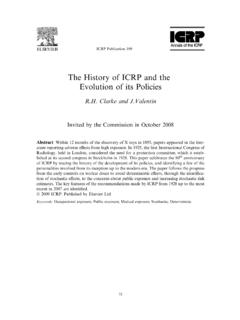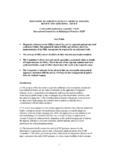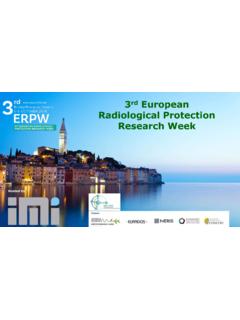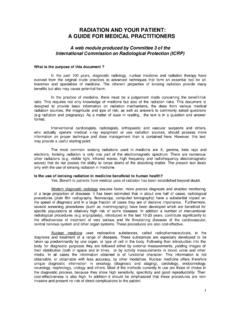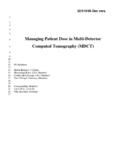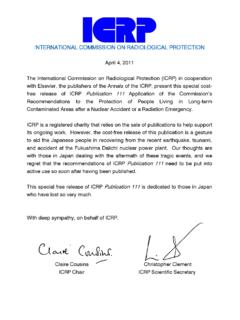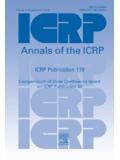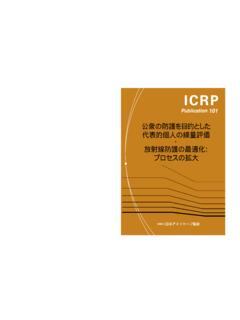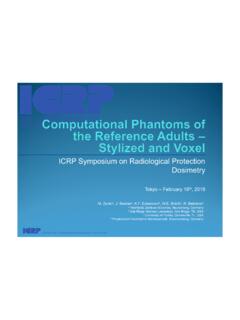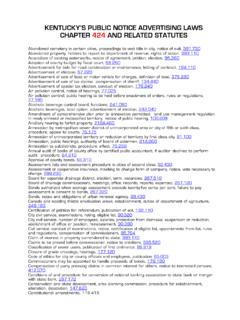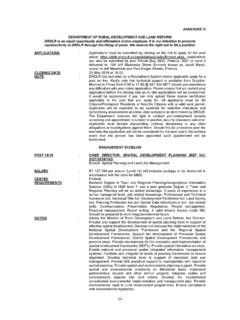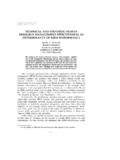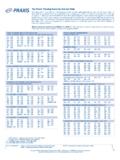Transcription of DRAFT REPORT FOR CONSULTATION: DO NOT …
1 DRAFT REPORT FOR CONSULTATION: DO NOT REFERENCE 1 ICRP ref 4811-7254-2307 1 24 April 2018 2 3 4 5 Annals of the ICRP 6 7 8 9 ICRP PUBLICATION 1XX 10 11 12 The Use of Effective Dose as a 13 Radiological Protection Quantity 14 15 16 17 18 Editor-in-Chief 19 CLEMENT 20 21 Associate Editor 22 H. FUJITA 23 24 25 Authors on behalf of ICRP 26 Harrison, M. Balonov, F. Bochud, Martin, H-G. Menzel, 27 P. Ortiz-Lopez, R. Smith-Bindman, Simmonds, R. Wakeford 28 29 PUBLISHED FOR 30 The International Commission on Radiological Protection 31 by 32 33 [SAGE logo] 34 Please cite this issue as ICRP, 20YY.
2 The Use of Effective Dose as a Radiological 35 Protection Quantity. ICRP Publication 1XX, Ann. ICRP XX(X), 1-XX. 36 37 DRAFT REPORT FOR CONSULTATION: DO NOT REFERENCE 2 38 CONTENTS 39 [Guest] 4 40 ABSTRACT .. 5 41 PREFACE .. 7 42 MAIN 8 43 1. INTRODUCTION .. 11 44 2. HEALTH EFFECTS .. 13 45 Categories of effect .. 13 46 Tissue reactions (Deterministic effects) .. 13 47 Cancers and hereditary diseases (Stochastic effects) .. 15 48 Nominal risk coefficients and Detriment .. 15 49 Tissue weighting factors .. 19 50 Age- and sex- specific cancer risks.
3 20 51 Risks from alpha particle emitting 23 52 3. 25 53 Dose quantities .. 25 54 Absorbed dose .. 25 55 Equivalent dose .. 26 56 Effective dose .. 28 57 Dose coefficients .. 29 58 Skin dose .. 31 59 Operational quantities and dose 32 60 Collective dose .. 34 61 4. OCCUPATIONAL AND PUBLIC 35 62 Occupational Exposures .. 35 63 Public Exposures .. 38 64 Collective dose assessments .. 41 65 5. MEDICAL EXPOSURES .. 42 66 Effective dose from medical procedures .. 43 67 Justification of procedures .. 44 68 Optimisation and reporting of doses.
4 45 69 DRAFT REPORT FOR CONSULTATION: DO NOT REFERENCE 3 Effective dose and risk communication .. 47 70 6. SUMMARY AND CONCLUSIONS .. 54 71 REFERENCES .. 58 72 73 74 DRAFT REPORT FOR CONSULTATION: DO NOT REFERENCE 4 [Guest] Editorial 75 76 To be drafted. 77 78 DRAFT REPORT FOR CONSULTATION: DO NOT REFERENCE 5 ABSTRACT 79 80 The Use of Effective Dose as a 81 Radiological Protection Quantity 82 83 ICRP PUBLICATION 1XX 84 85 Approved by the Commission in MONTH 201X 86 87 88 Abstract-The concept of effective dose (E) was developed by ICRP as a risk-adjusted 89 dosimetric quantity for the management of protection against stochastic effects, principally 90 cancer, enabling comparison of planned or received doses with dose limits, dose constraints, 91 and reference levels expressed in the same quantity.
5 Its use allows all radiation exposures 92 from external and internal sources to be considered together and summed, relying on the 93 assumptions of a linear-non-threshold dose-response relationship, equivalence of acute and 94 chronic exposures at low doses or low dose rates, and equivalence of external and internal 95 exposures. Considering exposures incurred by patients during medical procedures, E is of 96 practical value for comparing: doses from different diagnostic examinations and 97 interventional procedures; the use of similar technologies and procedures in different 98 hospitals and countries.
6 And the use of different technologies for the same medical 99 examination, provided that the representative patients or patient populations for which the 100 effective doses are derived are similar with regard to age and sex. As stated in the 2007 101 Recommendations (ICRP, 2007a), .. risk assessment for medical diagnosis and treatment 102 .. is best evaluated using appropriate risk values for the individual tissues at risk and for the 103 age and sex distribution of the individuals undergoing the medical procedures.
7 Publication 104 103 (ICRP, 2007a) provides detailed explanation of the purpose and use of E and of 105 equivalent dose to individual organs and tissues. However, questions have arisen regarding 106 practical applications, highlighting a clear need for further guidance on specific aspects. This 107 publication draws on the explanations provided in Publication 103 and emphasises that E has 108 proved a valuable and robust quantity for use in the optimisation of protection, to set dose 109 criteria and verify compliance.
8 Conclusions are drawn that: a) Equivalent dose (H) is not 110 required as a protection quantity. It will be more appropriate for limits for the avoidance of 111 tissue reactions for the hands and feet, lens of the eye, and skin, to be set in terms of absorbed 112 dose (Gy) rather than equivalent dose (Sv). b) While risk assessments for individuals based 113 on organ/tissue doses and specific dose-risk models make best use of scientific knowledge, E 114 may be used as an approximate indicator of possible risk, recognising that this is a pragmatic, 115 but unintended, application of effective dose.
9 It is made clear in this REPORT that while doses 116 incurred at low levels of exposure may be measured or assessed with reasonable accuracy, 117 the associated risks are increasingly uncertain at lower doses. However, bearing in mind the 118 uncertainties associated with risk projection to low doses, E may be considered as an 119 approximate indicator of possible risk, with the additional consideration of variation in risk 120 with age, sex and population group. Use of E in this way is not a substitute for risk analysis 121 using best estimates of organ/tissue doses, appropriate information on the relative 122 effectiveness of different radiation types, and age-, sex- and population-specific risk factors, 123 with consideration of uncertainties.
10 124 20YY ICRP. Published by SAGE. 125 DRAFT REPORT FOR CONSULTATION: DO NOT REFERENCE 6 126 Keywords: Absorbed dose; Equivalent dose; Effective dose; Stochastic risks 127 128 AUTHORS ON BEHALF OF ICRP 129 HARRISON, M. BALONOV, F. BOCHUD, MARTIN, H-G. MENZEL, 130 P. ORTIZ-LOPEZ, R. SMITH-BINDMAN, SIMMONDS, R. WAKEFORD 131 132 133 134 135 136 137 DRAFT REPORT FOR CONSULTATION: DO NOT REFERENCE 7 138 PREFACE 139 140 Experience has shown that the quantity effective dose which has been defined and 141 introduced by ICRP for risk management purposes, for risk limitation and optimisation, is 142 widely used in radiological protection and related fields beyond its original purpose, 143 incorrectly in some cases.
